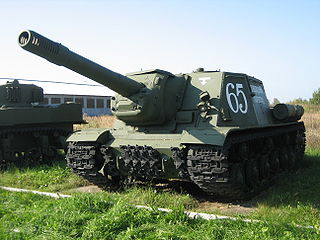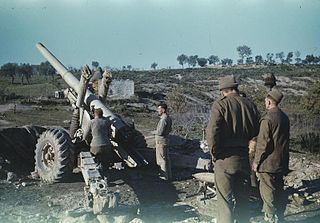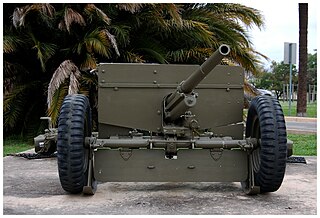
Self-propelled artillery is artillery equipped with its own propulsion system to move toward its firing position. Within the terminology are the self-propelled gun, self-propelled howitzer, self-propelled mortar, and rocket artillery. They are high mobility vehicles, usually based on continuous tracks carrying either a large field gun, howitzer, mortar, or some form of rocket/missile launcher. They are usually used for long-range indirect bombardment support on the battlefield.

The Infantry Tank Mark II, best known as the Matilda, is a British infantry tank of the Second World War.

The ISU-152 is a Soviet self-propelled gun developed and used during World War II. It was unofficially nicknamed Zveroboy in response to several large German tanks and guns coming into service, including Tigers and Panthers. Since the ISU-152's gun was mounted in a casemate, aiming it was awkward, and had to be done by repositioning the entire vehicle using the tracks. Therefore, it was used as mobile artillery to support more mobile infantry and armor attacks. It continued service into the 1970s and was used in several campaigns and countries.

The Ordnance QF 25-pounder, or more simply 25-pounder or 25-pdr, with a calibre of 3.45 inches (87.6 mm), was a piece of field artillery used by British and Commonwealth forces in the Second World War. It was often described as being durable, easy to operate and versatile. It was the major British field gun and howitzer during the War.

The M10 tank destroyer was an American tank destroyer of World War II. After US entry into World War II and the formation of the Tank Destroyer Force, a suitable vehicle was needed to equip the new battalions. By November 1941, the Army requested a vehicle with a gun in a fully rotating turret after other interim models were criticized for being too poorly designed. The prototype of the M10 was conceived in early 1942 and delivered in April that year. After appropriate changes to the hull and turret were made, the modified version was selected for production in June 1942 as the 3-inch Gun Motor Carriage M10. It mounted a 3-inch gun M7 in a rotating turret on a modified M4 Sherman tank chassis. An alternate model, the M10A1, which used the M4A3 variant chassis, was also produced. Production of the two models ran from September 1942 to December 1943 and October 1942 to November 1943, respectively.

The Ordnance Quick-Firing 6-pounder 7 cwt, or just 6-pounder, was a British 57 mm gun, serving during the Second World War as a primary anti-tank gun of both the British and United States Army. It was also used as the main armament for a number of armoured fighting vehicles.

The Ordnance QF 2-pounder, or simply "2 pounder gun", was a 40 mm (1.575 in) British anti-tank gun and vehicle-mounted gun employed in the Second World War.

The BL 5.5-inch gun was a British artillery gun introduced during the middle of the Second World War to equip medium batteries.

The 75 mm gun, models M2 to M6, was the standard American medium caliber gun fitted to mobile platforms during World War II. They were primarily mounted on tanks, such as the M3 Lee and M4 Sherman, but one variant was also used as an air-to-ground gun on the B-25 Mitchell medium bomber aircraft. There were five main variants used during the war: M2, M3, M4, M5 and M6.

122 mm corps gun M1931/37 (A-19) was a Soviet field gun developed in late 1930s by combining the barrel of the 122 mm gun M1931 (A-19) and the carriage of the 152 mm howitzer-gun M1937 (ML-20). The gun was in production from 1939 until 1946. It saw action in World War II and remained in service for a long time after the end of the war. Vehicle-mounted variants of the gun were fitted to the IS-2 and IS-3 tanks of the Iosif Stalin series of tanks and the ISU-122 self-propelled gun.

T-20 armored tractor Komsomolets(Bronirovannyy gusenichnyy tyagach Komsomolets T-20), an armored continuous track tractor, the T-20 was a prime mover vehicle used by the Soviet Union during the Winter War and World War II.

The ZiS-2 is a Soviet 57 mm anti-tank gun used during World War II. The ZiS-4 is a version of the gun that was meant to be installed in tanks. ZiS stands for Zavod imeni Stalina, the official title of Artillery Factory No. 92, which produced the gun first.

The 37 mm gun M3 is the first dedicated anti-tank gun fielded by United States forces in numbers. Introduced in 1940, it became the standard anti-tank gun of the U.S. infantry with its size enabling it to be pulled by a jeep. However, the continuing improvement of German tanks quickly rendered the 37 mm ineffective and, by 1943, it was being gradually replaced in the European and Mediterranean theaters by the more powerful British-developed 57 mm gun M1. In the Pacific, where the Japanese tank threat was less significant, the M3 remained in service until the end of the war, but some 57mm guns were issued.

The D-1 howitzer M1943 is a Soviet World War II-era 152.4 mm howitzer. The gun was developed by the design bureau headed by F. F. Petrov in 1942 and 1943, based on the carriage of the 122 mm howitzer M1938 (M-30) and using the barrel of the 152 mm howitzer M1938 (M-10). The powerful and mobile D-1, with its wide range of ammunition, significantly increased the firepower and breakthrough abilities of Red Army tank and motor rifle formations. Several hundred D-1s were manufactured before the end of World War II.

The 122 mm howitzer M1938 (M-30) is a Soviet 121.92 mm (4.8 inch) howitzer. The weapon was developed by the design bureau of Motovilikha Plants, headed by F. F. Petrov, in the late 1930s, and was in production from 1939 to 1955. The M-30 saw action in World War II, mainly as a divisional artillery piece of the Red Army (RKKA). Captured guns were also employed later in the conflict by the German Wehrmacht and the Finnish Army. Post World War II the M-30 saw combat in numerous conflicts of the mid- to late twentieth century in service of other countries' armies, notably in the Middle East.

152-mm howitzer M1938 (M-10) was a Soviet 152.4 mm howitzer of World War II era. It was developed in 1937–1938 at the Motovilikha Mechanical Plant by a team headed by F. F. Petrov. Although production of the gun was stopped in 1941, it saw combat with the Red Army until the end of World War II and remained in service until the 1950s. Captured pieces were used by Wehrmacht and the Finnish Army. The latter kept the M-10 in service until 2000.

The Type 1 47 mm anti-tank gun was an anti-tank gun developed by the Imperial Japanese Army, and used in combat during World War II. The Type 1 number was designated for the year the gun was accepted, 2601 in the Japanese imperial year calendar, or 1941 in the Gregorian calendar.

2.8 cm schwere Panzerbüchse 41 or "Panzerbüchse 41" was a German anti-tank weapon working on the squeeze bore principle. Officially classified as a heavy anti-tank rifle, it would be better described, and is widely referred to, as a light anti-tank gun.

The 107 mm divisional gun M1940 (M-60) was a Soviet artillery piece, developed in the late 1930s in order to provide Soviet divisional artillery with a powerful field and anti-tank gun. The weapon entered production in 1940, but soon after the outbreak of the German-Soviet War, production ceased; only a limited number of pieces were built. These guns saw service in the Red Army during the war.

122 mm corps gun M1931 (A-19) was a Soviet field gun, developed in the late 1920s and early 1930s. In 1939 the gun was replaced in production by an improved variant, M1931/37. The piece saw action in World War II with the Red Army. Captured guns were employed by Wehrmacht and the Finnish Army.




















